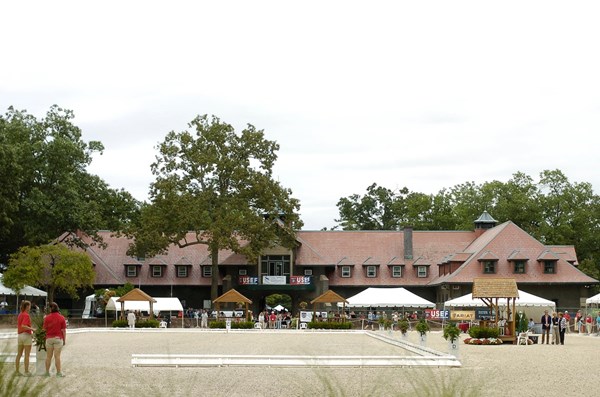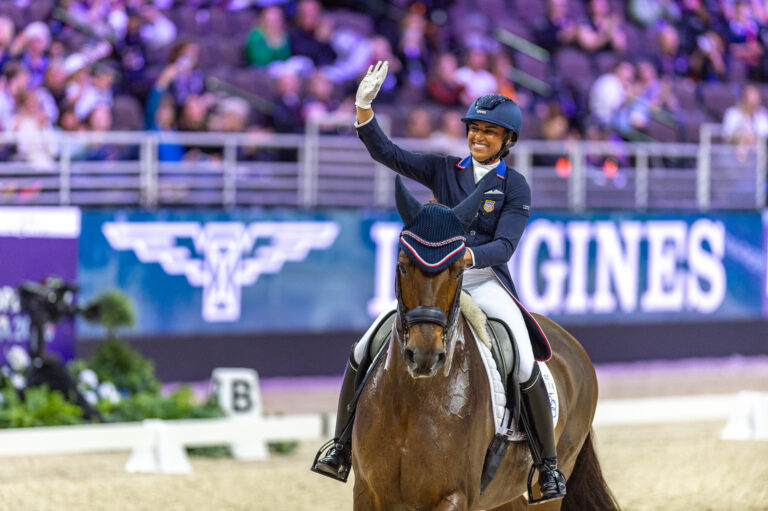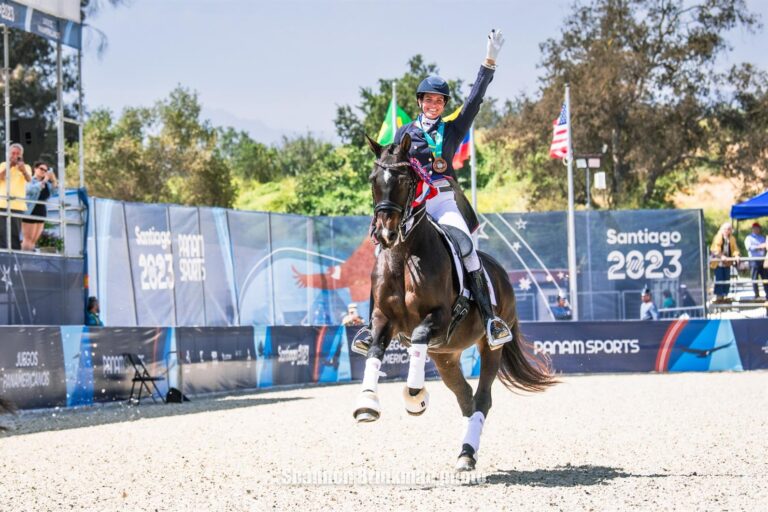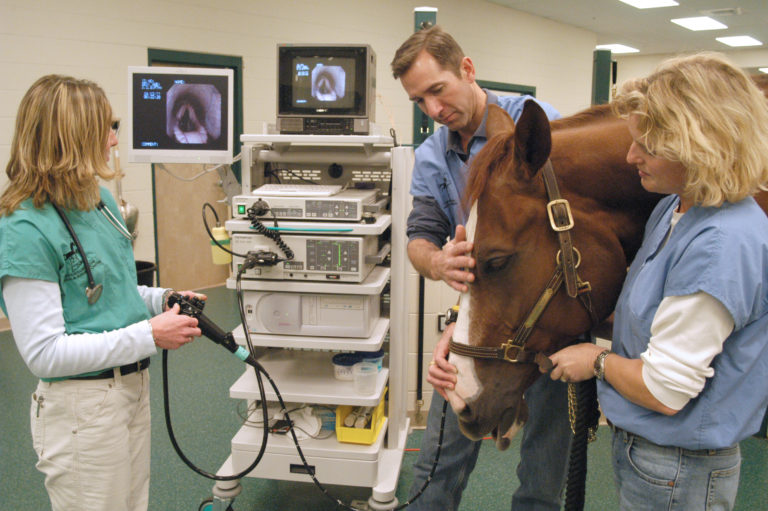
It’s like coming home,” observed former USEF Technical Advisor and FEI 5-star judge, Anne Gribbons, expressing her feelings about the 2017 USEF Grand Prix, Intermediaire I and Brentina Cup Championships returning to the U.S. Equestrian Team (USET) Foundation headquarters in Gladstone, New Jersey, May 18–21.
For decades, the facility known around the world simply as “Gladstone” was respected as the USET’s training center, where revered coaches such as Bertalan de Nemethy, Jack Le Goff and Bengt Ljungquist presided over teams that brought glory to America on the international equestrian scene. Although these days the focus of the foundation, based at the 99-year-old stable, involves raising funds for international competition, the charm and reputation of Gladstone still have cachet.

The stately trees and landmark building, with its tile floor and brass finials on the stalls, offer the sense of a very special location. A visit to the upstairs trophy room reveals a history of the U.S. squads in all disciplines, going back to the days when the Army was in charge of fielding teams for international competition. “I really love the place and appreciate the intimacy of it,” said Gribbons, a member of the USEF High Performance Dressage Committee who has been to Gladstone as both a competitor and coach. Her enthusiasm is shared by many others, including George Williams, also a member of the USEF committee and president of the USDF—which has its own set of championships.
“I really do like Gladstone for its history,” said Williams, who became part of it when he rode Rocher to the national Grand Prix championship there in 2005. “It’s a beautiful spot. When you go there you feel the history—it affects everyone. You think about the people who have ridden there before.”
Robert Dover, who competed and coached at Gladstone many times, believes it’s a great location for the three championships. “I’m very excited it’s going to be at Gladstone,” he enthused, noting they likely will be held there in 2018 and 2019 as well, although those plans have not yet been formally announced. “Gladstone obviously has a really, really strong place in my heart. It’s been the traditional place of the Festival of Champions,” said Dover, who enjoys fond memories of those multi-discipline championships, when driving, show jumping and endurance were also on the program, and would like to see that happen again someday. “The community also is very excited to have Gladstone be the venue for the festival again. They were so supportive,” he continued, referring to the number of spectators and volunteers who came from the area, which is very horse-oriented.
The championships once were a fixture at Gladstone, where as part of the festival they ran the gamut from ponies up through the top ranks of the sport. They did move away several times, however. In 2004, for instance, they were in California before heading back to Gladstone. They returned to California’s San Juan Capistrano in 2008, when the equestrian portion of the Olympics was in Hong Kong. A West Coast venue was better suited to the 2008 championships because it was closer to Asia than the East Coast. But the dressage title meet returned to Gladstone from 2009 until 2013, when it went to Kentucky. It was held at Gladstone in 2014 for the World Equestrian Games selection trials, but then was split. The Pony Rider, Junior, Young Rider, Young Adult Brentina Cup Championships and the USEF Dressage Seat Medal ran in conjunction with the Markel/USEF Young and Developing Horse Dressage National Championships at the Lamplight Equestrian Center in Wayne, Illinois. They will be held there again this year from Aug. 24–27. The Grand Prix and Intermediaire I Championships were presented at the Adequan Global Dressage Festival grounds in Wellington, Florida, in 2015. Those championships weren’t held in 2016, however, after one California venue fell through and there were problems with finding another. Meanwhile, the run-up to the Olympics took its toll on the entries that could be expected to appear on the West Coast in the autumn.
“We have struggled in the committee forever to try and move it around,” Gribbons said of the championships, “because it’s fair to have it at least East and West on alternate years. I agree that this would be much more fair to the West Coast people.” It hasn’t worked, however, and she recalled there were stabling problems that had the riders concerned about their horses when the 2008 competition was in California. “Time and again, we’ve tried to put it in California. We tried several facilities. For some reason either the actual venue didn’t work out or they ran into unforeseen problems or the dates weren’t right,” Gribbons said. She added that if a venue on the West Coast could be found that met the right criteria and could be expected to stay the same year-in and year-out, organizers would try again.
In the meantime, she pointed out, everyone who is serious about competing in a championship or trying for a team is able to get themselves to Wellington, where the Adequan Global Dressage Festival is the hotspot of the discipline in the U.S. And if they can get to Wellington, they can get to Gladstone, she noted. “It’s not as big a deal to go cross-country as it used to be. Top riders seem to be able to fly their horses with more ease. They hardly ever travel by land anymore. I understand it is not fair to have everything on the East Coast, but what I always liked about Gladstone is that it is our home. I went there for many training sessions under several coaches when I was going for the team. It’s a beautiful place, really old America. I love the atmosphere.” She noted there is another big plus for Gladstone. “We can do whatever we want there, within limits, of course. We can ask for things we cannot ask for at another facility because they will do their best to accommodate championship riders.”
Dates are a key issue and while the championships usually were held in June at Gladstone, having the competition in May makes it the perfect take-off point for horses and riders going to Europe for the summer shows, such as Aachen.
“I think it’s a very positive thing and I like this time of year,” said 2004 Olympic team-bronze medalist Lisa Wilcox. “It’s perfect timing to go into a national championships coming out of the amped-up season we have in Florida, and then to head off to whatever it may be—World Equestrian Games preparation, team selection or Olympic Games preparation and selection. I really do like Gladstone for its history and what it represents. I think it’s a great place to be having our national championship.”
Splitting the championships between Gladstone and Lamplight enables riders to focus on specific goals, concentrating on the Grand Prix and Intermediaire I in New Jersey and giving proper attention to the young horses in Illinois, she mentioned. While it would be good in theory to have all the championships together again, the current two-part arrangement seems destined to continue.
“It was nice for the youth to be able to compete alongside the senior riders or the Olympic riders and contenders because it’s inspiring for them to feel a part of it,” said Williams. But, he added, there are a few difficulties. “Although Gladstone is a wonderful venue for this, it’s basically a one-arena competition, so it is limited in the number of competitors it can accommodate. The plus side in what the two years have shown in having the youth as part of the Young and Developing Horse Championships is that it has turned that competition into potentially the stars of our future. With that, and especially having the developing Grand Prix, it’s a wonderful mix. Lamplight works very well because you have two championship arenas going side by side. So you can be focused and watch one, if that is your interest, or you can go back and forth between the two arenas. The Dressage Seat Medal Finals also fit in very well there.” He pointed out that with so many young participants, their championships need to be held in the summer during the school vacation, which means the mid-May dates of Gladstone wouldn’t work for that group of competitors.
USET Foundation Executive Director Bonnie Jenkins is pleased to welcome the championships again to a facility that has had a lot of work done on everything from the footing to the stabling.
“Bringing the National Dressage Championships back to Hamilton Farm in Gladstone is going to be very special,” she commented. “Not only will we have a top-level national dressage competition, we will also be celebrating the 100th anniversary of the stable. The riders and horses will be the first to walk down the grand aisle and christen the newly renovated stalls that have been refurbished board by board, hardware repaired and floors sealed with state-of-the-art rubber for the horses’ ultimate comfort and welfare. The stable will be gleaming with brass polished and ready to showcase this country’s best dressage riders. I hope everyone will come out and join us in celebrating our U.S. dressage riders and the 100th anniversary of the Hamilton Farm Stable.”











